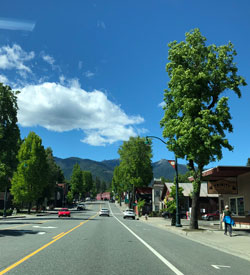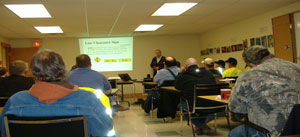U.S. Department of Transportation
Federal Highway Administration
1200 New Jersey Avenue, SE
Washington, DC 20590
202-366-4000

Photo courtesy of Molly O’Brien,
Kimley-Horn and Associates, Inc.
A Local Road Safety Plan (LRSP) is a Federal Highway Administration (FHWA) proven safety countermeasure1 that provides a framework for identifying, analyzing, and prioritizing roadway safety improvements on local roads. While several States and local agencies have adopted this approach as a tool to improve safety on their local roads, many are finding it difficult to go from development to implementation. This report provides strategies local agencies and States have used to overcome barriers and challenges to successfully implement their plans.
Successful LRSP implementation starts during the plan development process. The LRSP development process can help make the implementation process more successful, and the following items should be considered when putting together a LRSP:
If a LRSP already exists, recommendations include actions that build on what was accomplished in the development process including:
Research conducted for the report also identified differences in LRSPs and how that impacts implementation. The research did not reveal a correlation between how LRSP development was funded and implementation of the projects in the LRSP. Who develops the LRSP (consultants or agency staff), does not necessarily impact implementation either. In States the use of a single consultant to prepare LRSPs for multiple local agencies using a consistent methodology can result in an easier project selection process by the State DOT when the local agency applies for funding to implement projects.
The geographic area (single agency or region) also does not impact implementation but there are pros and cons for both. For instance, coordination and buy in may be easier in a single agency plan. However, there are finite resources in a single agency and because of the size of the community, there are fewer stakeholders who may be able to participate given their current workload. Regional plans lend themselves to a systemic safety approach (systemic safety can also be done in a local area), and there can be more stakeholders who participate and are active. A larger group of stakeholders, however, can make reaching consensus more challenging and different agencies may have different priorities. The way projects are selected also varies and it is important to consider how the local agency plans to obtain funding, and the requirements of that funding mechanism. There should also be a clear understanding of the level of project development that is required to obtain the funding for projects that will be implemented.
When it comes to implementation there are several key steps that will ensure the effort is successful including the following:

Photo courtesy of Brian Keierleber, Buchanan County, IA
Maintain buy-in and support from key officials in the agency and those outside the agency, (e.g., elected officials) which can be accomplished by meeting with any agency or elected officials that have changed since the plan was developed; conducting on-going, regular meetings for stakeholders to keep them informed; developing a fact sheet on the LRSP; conducting briefings and presentations at board and agency meetings; collecting and sharing important information on a regular basis; and bringing in other offices in the local agency that may be able to help such as maintenance.
Part of maintaining buy-in and support is to identify a champion. A champion is the individual who speaks about the plan at meetings, promotes the plan at meetings with State officials, and becomes the public face of the LRSP to officials and stakeholders. Having a champion who can articulate what is being implemented can make the process of confirming or obtaining support from key individuals easier. That champion can be a local person or someone at the State level. In most locations with LRSPs, the champion is the county engineer, county supervisor, or city engineer.
In Washington State, the champion comes from the State DOT (Local Technical Assistance Program (LTAP)) and is the person who oversees all local road safety initiatives. The Washington State DOT felt this gave the individual perspective on the issues and the knowledge and authority to address related problems. The individual initially met with all the counties and got many to agree to develop and implement the LRSP. This champion provides a consistent message, helps initiate conversations with other agencies, and generates insight for improving the process overall. While several LRSPs were started with support and involvement from the DOT, other efforts were generated locally.
Identify funding mechanisms by meeting with the local agency manager or the Executive Directors of Metropolitan Planning Organizations (MPO) in the area to find out what funding is available locally for safety projects. It is also a good idea to meet with the relevant personnel at the DOT who administers the Highway Safety Improvement Program (HSIP) funding to find out the requirements and application process. Review the current list of capital improvement projects to determine where recommendations from the LRSP overlap with future planned projects and determine whether it is possible to fund portions of the LRSP through public/private partnerships. While HSIP is the mechanism used most often to fund LRSP projects, there are other sources including bicycle/pedestrian improvement funding; sign replacement programs; MPO funding; Tribal transportation safety funding; specialty bond programs; Active Transportation Program; and inclusion of the LRSP in the county budget.
Identify and prioritize projects based on potential effectiveness and available resources (funding, staff). While identification of projects usually takes place during development, there may be a need to further identify projects during implementation which can be done through network screening and the systemic safety analysis process. Methods of project prioritization can include data analysis that selects projects based on crash histories or risk factors; regional safety prioritization which links to other plans in a region like Safe Routes to Schools; benefit-cost analysis which prioritizes projects based on those with the highest benefit when compared to the cost; and other methods such as field visits to review site conditions, selection based on the number of risk factors, and the ability to piggyback on already planned projects or for a policy or political reason.
Steps for Successful LRSP Implementation

Determine project delivery methods which is what occurs after all necessary funding has been secured. Project delivery usually starts with the design of a project and in some cases can be a design-build effort where the design and construction happen simultaneously. Project bundling where multiple projects of the same type are bundled together or where multiple agencies bundle projects can lessen the financial and management burden, and on-going maintenance can be utilized for project implementation. For instance, integrating the LRSP projects with pavement resurfacing, restoration, and preservation efforts.
Evaluate the plan’s effectiveness in reducing fatalities and serious injuries after implementation. There are several ways to evaluate the effectiveness of the LRSP. The first is to compare the number of fatalities and serious injuries before the plan projects were implemented and after implementation. Benefit-cost analysis can also determine if a project is effective but it can also be the number of local agencies who make the LRSP part of their daily business, and the number of projects that were implemented or the number of applications for funding that were received. Evaluation can take place when a LRSP is updated either because conditions change or on an update schedule. LRSP owners can also identify metrics that track progress such as the number of miles of rumble strips that have been installed. Expanding stakeholders is another way to continue the effectiveness of the effort by bringing in new voices and ideas.
Continue active communications and coordination with agency colleagues, partner agencies, and the public by ensuring stakeholders are all on board for implementation; by aligning messaging across communication channels and programs; meeting with elected officials and attending committee and board meetings and workshops; hosting conferences/webinars to keep a focus/awareness on local road safety; and developing and distributing newsletters or other regular communication. Other ideas include conducting regular presentations to the county, city, or regional board or council, posting photographs and information on social media; and scheduling a meeting with key officials if you know a project may generate some opposition.
LRSPs have been developed throughout the U.S. at the county, city, Tribal, or regional level (State DOT district or region, MPO). While development of LRSPs is widespread and continuing to grow, implementation of LRSPs has been challenging for some agencies. A plan cannot reach the goal of reducing traffic related fatalities and serious injuries if it is not implemented. Recognizing the challenges State, local, Tribal and regional agencies face, this report provides guidance and examples of how to successfully address and accomplish LRSP implementation. Whether the issue is funding, lack of support, or an uncertainty on how to move forward, there are a number of localities and States that are achieving implementation success. Their experience, coupled with what the research indicates are effective approaches, provide a road map on how to move forward from development to execution. Achieving success takes hard work and effort, but the results are worth it when considering the goal is to save lives and prevent injuries.
1 FHWA, Office of Safety, Proven Countermeasures. [Return to footnote 1]
| << Previous | Table of Contents | Next >> |
